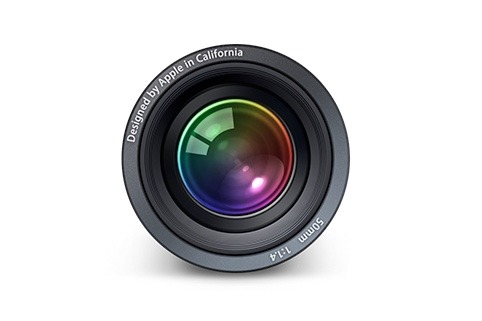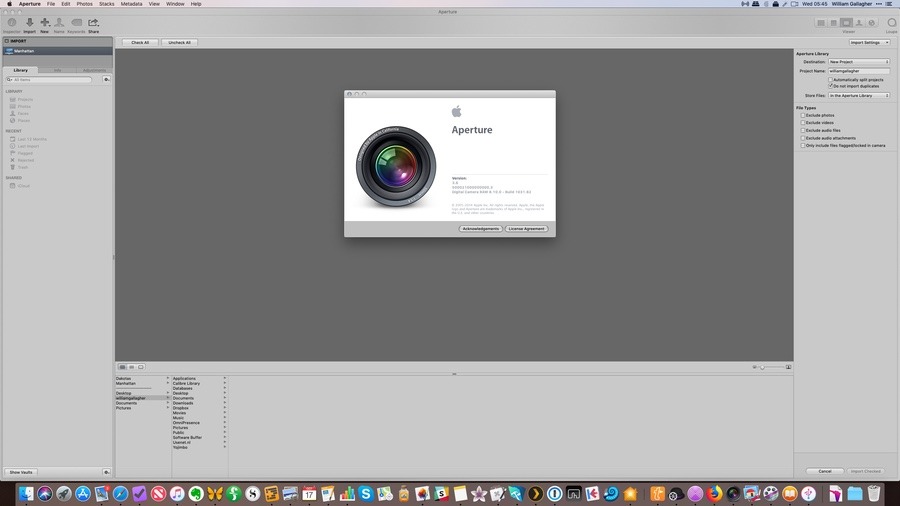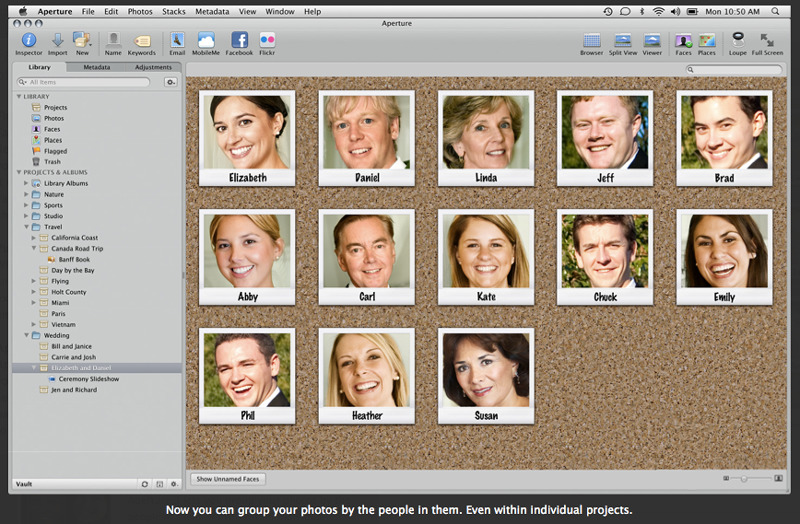On October 19, 2005, Apple released a new tool for professional photographers. It promised much, it ultimately delivered a great deal, and it has fans to this day. AppleInsider talks about the major Apple app that the company killed.
Every single day we are surrounded by unimaginable technology, and we all look forward to what's coming next. Yet when something new comes, we have a peculiar habit of trying to frame it in terms of what has gone before.
So when rumors of Aperture first surfaced, the common reaction was to assume that this was Apple attempting to make their own version of Photoshop. Aperture was for editing photos, it did feature some tools that photographers know from Adobe's software.
Apple's software wasn't Photoshop, it was a new class of app entirely. It was for photographers to handle large numbers of photographs, to do the kind of processing and editing they need daily, and then to send these images on to clients.
When you assume that Apple was trying to mimic Photoshop, you have to conclude that they failed immediately. The features in Aperture were the smallest fraction of what that image editor can do.
Then Adobe released Lightroom, a very similar idea to Aperture, and that seemed to validate the concept. There were key differences between the two but they both aimed to serve pro photographers.
Adobe Lightroom succeeded and is still in use today. Apple's Aperture is no longer in development or on sale.
It's a surprising story because Aperture had much going for it. The Mac is the preferred computer of photographers across the world and Aperture addressed a genuine need. It's too simplistic to blame its failure on a handful of specific issues but as a whole those problems do mean that Aperture is a major Apple app that died.
First sight
Apple released Aperture 1.0 on October 19, 2005 and followed it before the end of the year with a bug-fixing 1.0.1. Announcing that original release, Apple said it was: "the first all-in-one post production tool that provides everything photographers need after the shoot."
The company also quoted Heinz Kluetmeier, a sports photographer known for shooting over 100 Sports Illustrated covers at the time.
"What amazed me about Aperture is that you can work directly with RAW files, you can loupe and stack them and it's almost instantaneous," said Kluetmeier. "I suspect that I'm going to stop shooting JPEGs. Aperture just blew me away."
While its features seem familiar today, the way that Aperture grouped photos into stacks or collections based on when they were taken was new. It automated part of the process of working on a shoot.
There was perhaps one more thing that made this a professional's app instead of a consumer's one — it cost $499.
Lightroom
That 1.0.1 release of Aperture came on December 21, 2005 and then on January 9, 2006, Adobe released a beta of Lightroom for the Mac. It was only for the Mac then, too, so at the time it seemed like Adobe copying Aperture.
In truth, Lightroom had been in the works in various forms since 1999. That was seven years before, so you can imagine that the release of Aperture was a wake-up call to Adobe.
Adobe still didn't rush. The beta period lasted through 2006, most notably adding a Windows version in July of that year.
The difference between Aperture and its rival Lightroom was as much philosophical as technical. The two apps expected different things from their users.
Lightroom expected you to first shoot a lot of images. Then, you sorted and named them, you deleted what you didn't want. Next, you did light editing or passed the image on to Photoshop. You went through this process and you went through it in that sequence.
Aperture expected you to do exactly the same steps, but in any order you liked. You obviously had to shoot photos first but then you could edit these ten now and go back to delete these other twenty later.
Lightroom was comparatively rigid and maybe you liked that, maybe you preferred Aperture's freer approach. Anecdotally, though, with Lightroom you tended to deal with images and be done with them. Whereas with Aperture your image library rather grew and sprawled.
Lightroom was officially released on February 19, 2007. If you were already an Adobe user as so many photographers were, then this was positioned as an addition to Photoshop. It was also priced at $199, half the cost of Aperture.
The pricing gap lasted for about a year. On February 12, 2008 Apple released Aperture 2.0 and dropped the price to that same $199.
Apple turned to a different Sports Illustrated photographer, David Bergman, who said that "even before I begin making adjustments, Aperture's new RAW processing gives me better images with more visible detail and better color rendering than any other program I've tested."
Staying in Aperture
Oddly, though, Aperture 2.0 was arguably not as big of an update as Aperture 2.1 which came just over a month later on March 28, 2008. That release added the ability for developers to produce their own features for the app.
This process might seem familiar to Apple users. Early versions are pretty tightly constrained, with a later version adding developer hooks or other extensions.
With Aperture 2.1, rather than exporting your image to something like Photoshop to do greater editing, you could do more inside Aperture because developers could use plugins.
Apple tried to spin this both ways. It made this sound like a great new feature that would mean you don't have to leave Aperture so often, but also that you hardly ever have to anyway.
Time and National Geographic contributing photographer John Stanmeyer was cited in Apple's press release pointing out the debut of the new version.
"To date, maybe two percent of my photographs needed to be touched up outside Aperture," said Stanmeyer. "Now that I can dodge and burn right within Aperture's new plug-in, I can't imagine when I'll have to open any other application to tone my images."
Catching on
It was really not until Aperture 3.0 on February 9, 2010, that the software appeared to be catching on. That release boasted more than 200 new features and AppleInsider recognized that some were significant.
This is where Apple introduced Faces, its face detection and recognition tool that we now see in Photos. This was startling: the software would automatically group together all the photos with your Aunt Mabel in them.
It wasn't flawless and it often made some perplexing mistakes but you could tell it that no, this is Uncle Jim instead, and it would learn.
It was still a very impressive new tool even though it felt more like one for consumers. Professionals working on a shoot know who they are shooting, after all. You can see that maybe this would help them searching their archive for past coverage of the same people but it was still a feature that impressed more than it would be used.
There was also now the ability to send your images to Facebook, again making this feel more like a consumer tool.
However, the most significant clue that Apple might be changing its focus to the consumer was the price. Aperture 3.0 sold for $80.
You can perhaps see how Apple was in two minds about the market for Aperture at this time by seeing how it was used in a 2012 Apple Keynote.
The end
Aperture had its fans but at the time, you felt as if it weren't getting a lot of attention from Apple. In reality, it was being steadily updated: every few months there would be at least a bug-fix release.
Nonetheless, the final major update was on October 22, 2013 with Aperture 3.5. There was one bug fix 3.5.1 in the November and then in October 2014, Apple released Aperture 3.6 but the sole feature of that was compatibility with OS X Yosemite.
Aperture was already dead by then: Apple had officially ceased development and sale of it three months earlier on June 27.
Adobe Lightroom won. It's one thing to be beaten by a rival, but this time Apple rather publicly conceded victory. It announced it was recommending users switch to Lightroom.
Today Aperture is all but forgotten and Apple's consumer Photos app does much of what it did — but it certainly didn't at the launch of the consumer app. But, more about that, on another day.
There's no question but that Lightroom is more successful. But, it's hard to measure how much it is actually being used. Lightroom is part of Adobe's Creative Cloud suite and so you may have it without even noticing.
Neither app was a tool for everybody, Aperture was and Lightroom is a niche application, but what they set out to do, did create a new class of software for users pro and casual. They both launched a genre of apps that professional photographers would now find difficult to do without.
Keep up with AppleInsider by downloading the AppleInsider app for iOS, and follow us on YouTube, Twitter @appleinsider and Facebook for live, late-breaking coverage. You can also check out our official Instagram account for exclusive photos.
 William Gallagher
William Gallagher




-m.jpg)








 Andrew O'Hara
Andrew O'Hara
 Wesley Hilliard
Wesley Hilliard

 Malcolm Owen
Malcolm Owen
 Marko Zivkovic
Marko Zivkovic





-m.jpg)




37 Comments
We’ve discussed this a number of times. I was there when aperture was released. It looked great. It seemed that Apple could wrest a fair amount of business from Adobe. It wasn’t to be.
if anyone read the early reviews, they would have seen the problems. Apple decided that they were goi g to fix the images for us. So importing images was easy, but when we looked at them, they were altered. Not by a little bit, as Photoshop and other pro RAW editors do, but in a major way. Apple lifted the shadows by a couple of stops, did color correction, and a number of other things.
this isn’t what you want in a pro editor. In addition, while Photoshop had tools that were sophisticated, the lessor number that Apple had were much more primitive. They couldn’t do what Adobe’s did.
overall, it was a disappointment. I know that a fair amount of amateurs liked the software, but we were confused as to whom this was aimed at. Apple fixed some of the initial corrections in a point release, but it wasn’t enough. The tools were still too primitive.
if Adobe hadn’t been working on Lightroom, and released it shortly after, it’s possible the aperture might have survived, because Apple would have had enough time to fully (hopefully!) correct the problems. But Apple’s “help” with images, while just dandy for the amateurs using the software, was way too heavy handed for professionals who were used to the much more subtle corrections Adobe, and others. If Apple had fixed the tools quickly, that might have helped too.
i’ve gotten pushback about this here before, and I expect to again. But it’s the truth. I was sad about it too, as I, and others, were really hoping that what Apple had done, which was excellent in concept, would have matched that in utility, but it did not.
I'm still sore about Aperture going away. Apple has GarageBand and Logic, iMovie and Final Cut Pro X, iPhoto and.....
I still use Aperture and have always felt it to be superior to Lightroom. Paired with the also left-for-dead Google NIK Plugins, there isn't anything I can't do with my photos. I've found Lightroom to be unintuitive, clunky and overall unappealing. The Photos app is anemic and lacks the tools that made Aperture great. I will use Aperture until MacOS stops supporting it.
Aperture did NOT fail. Lightroom did NOT win. Aperture was, and still is, the superior product of the two, by a wide margin.
The fate that befell Aperture was unjust, unfair and avoidable. It simply – unfortunately – fell foul of Apple's iCloud strategy.
Apple wanted the use of photos on its system to become invisibly streamlined, with all photos synchronising automatically between Macs and other devices via iCloud. And as far as that goes, they've got it working well. If all you do is snap photos with your iPhone, Apple's got you covered beautifully.
Unfortunately, it was hard to fit Aperture into this strategy because it's a Pro app that Apple wanted to shoehorn into a consumer solution, and they couldn't see how to do it. People who use Aperture will typically have huge photo libraries that are too big to consider integrating with iCloud – and probably multiple libraries in any case. Such users typically have dedicated hard drives for their photo libraries, so the idea of putting everything on iCloud is laughable.
So, not being able to see a sensible way forward for Aperture that wouldn't conflict with their plans for the new Photos app and make everything rather confusing, and because Aperture was "only" for pros and hobbyists (i.e. a small market), Apple decided to simply kill it and tell people to use Lightroom instead, in spite of the fact that Lightroom is an utterly different product that really doesn't do the same thing at all, and doesn't work in the same way. It wasn't an admission of defeat in Aperture itself; it was an admission that Apple didn't want to bother serving a market as small as the pro and hobbyist photographer market. That's what it boils down to; Aperture as a product was unsurpassed, and had an open-ended future.
The timing, too, was unbelievably awful. Apple made a BIG, BIG noise about how fantastic Aperture was on its new Mac Pro system (the cylindrical dustbin system, that is) when the Mac Pro was launched, and how this was going to be the perfect machine for pro photographers. It based a whole load of impressive advertising on this, and made Aperture look absolutely compelling and drool-worthy on the new Mac Pro.
Then, just as soon as the new machine was out and people had had a chance to buy it and Aperture, Apple killed Aperture. Of course, it then also allowed its new Mac Pro system to totally stagnate as well. And if those factors together don't tell you exactly what Apple thinks of its pro photographer users, the message will never get through to you. It conned them into investing in a software package (an admittedly wonderful software package) that it was just on the points of discontinuing both development and support for, and it conned them into buying a MASSIVELY expensive and comparatively underpowered dead-end system, that it would never significantly upgrade, on which to run that end-of-life software. Pro users could easily have spent a fortune on one of these turkeys. It was absolutely shameful behaviour for Apple to drop Aperture JUST AFTER it had used it as a big incentive to buy its expensive new Mac Pro.
Thank heavens I didn't buy one myself. Had I done so, I'd have been livid. But even given that I didn't, I still think Apple acted shamefully, and most of all I regret the loss of this wonderful piece of software which I so enjoyed using. I invested in it from the start and bought every upgrade, and expected to continue to use it for as long as I was taking photos. I really don't like Lightroom, so I don't use that. Photos isn't up to the job. So I'm back to managing my photos manually in folders again. Thanks a lot, Apple. Terrific work. Well done.
Of course, being Apple, they had to definitively kill the product. Any other company with a half-decent sense of commitment to its users would have either sold Aperture to another company and allowed it to continue development, or simply open-sourced the software so that it could, at the very least, be kept alive and running on modern hardware. But no. Apple holds its pro/hobbyist photographer users in such contempt that it just killed off the project in a way that meant there could be no future for it, and no way ahead for its users. And if that isn't an insult to those users, I don't know what is. Apple treated those people with the utmost contempt. Having just screwed the maximum amount of money it could out of the ones who were prepared to buy an expensive Mac Pro system, it immediately betrayed them utterly and left them with no way forward. It was and is absolutely disgraceful.
Aperture was my favourite Apple software product, and I'm not going to forgive Apple for killing it any time soon.
Yeah, I think Apple dropped the ball with Aperture. I hope they pick it up again. I also hope they make a full version for Final Cut for the new iPad pros. Before adobe beats them to it with an iPad version of premiere. They already announced a full version of photoshop for the iPad, so you know it’s coming. Come on Apple. Do it. Do it. Do it. https://youtu.be/K4eScf6TMaM